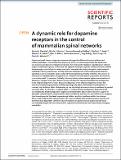A dynamic role for dopamine receptors in the control of mammalian spinal networks
Abstract
Dopamine is well known to regulate movement through the differential control of direct and indirect pathways in the striatum that express D1 and D2 receptors respectively. The spinal cord also expresses all dopamine receptors; however, how the specific receptors regulate spinal network output in mammals is poorly understood. We explore the receptor-specific mechanisms that underlie dopaminergic control of spinal network output of neonatal mice during changes in spinal network excitability. During spontaneous activity, which is a characteristic of developing spinal networks operating in a low excitability state, we found that dopamine is primarily inhibitory. We uncover an excitatory D1-mediated effect of dopamine on motoneurons and network output that also involves co-activation with D2 receptors. Critically, these excitatory actions require higher concentrations of dopamine; however, analysis of dopamine concentrations of neonates indicates that endogenous levels of spinal dopamine are low. Because endogenous levels of spinal dopamine are low, this excitatory dopaminergic pathway is likely physiologically-silent at this stage in development. In contrast, the inhibitory effect of dopamine, at low physiological concentrations is mediated by parallel activation of D2, D3, D4 and α2 receptors which is reproduced when endogenous dopamine levels are increased by blocking dopamine reuptake and metabolism. We provide evidence in support of dedicated spinal network components that are controlled by excitatory D1 and inhibitory D2 receptors that is reminiscent of the classic dopaminergic indirect and direct pathway within the striatum. These results indicate that network state is an important factor that dictates receptor-specific and therefore dose-dependent control of neuromodulators on spinal network output and advances our understanding of how neuromodulators regulate neural networks under dynamically changing excitability.
Citation
Sharples , S A , Burma , N E , Borowska-Fielding , J , Kwok , C H T , Eaton , S E A , Baker , G B , Jean-Xavier , C , Zhang , Y , Trang , T & Whelan , P J 2020 , ' A dynamic role for dopamine receptors in the control of mammalian spinal networks ' , Scientific Reports , vol. 10 , 16429 . https://doi.org/10.1038/s41598-020-73230-w
Publication
Scientific Reports
Status
Peer reviewed
ISSN
2045-2322Type
Journal article
Description
Authors acknowledge studentships from the Natural Sciences and Engineering Research Council of Canada (NSERC-PGS-D: SAS), the Canadian Institute for Health Research (CIHR: NEB), Alberta Innovates—Health Solutions (AIHS: SAS, NEB), Hotchkiss Brain Institute (SAS, NEB) and the Faculty of Veterinary Medicine (CHTK). This research was supported by grants from NSERC (Discovery grant: PJW), CIHR (PJW, YZ) and the VP Research Office and the Faculty of Medicine & Dentistry at the University of Alberta (GBB).Collections
Items in the St Andrews Research Repository are protected by copyright, with all rights reserved, unless otherwise indicated.

